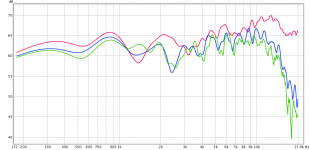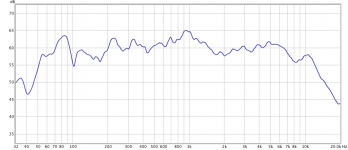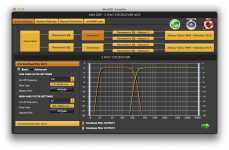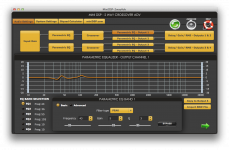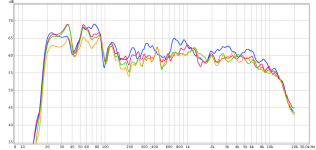First, compliments on your workmanship - the whole thing looks quite nicely done.
Thank you!
jReave said:Two specific things I designed the xo for that aren't in your measurements:
1 - off-axis listening
2 - the shelving unit as essentially one big front baffle.
So I would suggest trying again but this time with the shelves on both sides of the speaker filled in (or if that isn't easy, tape some cardboard over them) and with the mike moved vertically and horizontally so it's in line with your seated listening position (maybe about 6 - 10* vertically and about 18* horizontally).
Okay, I will try to cover the adjacent shelves with cardboard and make some measurements further out in the room and off-axis. I will try to measure the right speaker as well and compare. However, I guess that it will be difficult to do gated measurements if the mic is positioned far away from the speaker?
jReave said:Another thing to be aware of is that driver responses can change a touch with breakin, so you might want to run the mid for an afternoon or so with some low frequency content to give the suspensions a workout before the next measurement.
Gotcha. I’ll see if I have time to let the mids break in a little before making more measurements.
jReave said:Response also changes with SPL. Using 1W of power, SPL should be way up in the 80's but you are down around 60dB, at least on the graph anyways.
The SPL is not set correctly in REW. Measurements were definitely higher than 60dB. I don’t have much experience with measurements and I haven’t figured out how to set the SPL right in REW.
jReave said:Another thing I would do before the next measurement is make sure that the internal stuffing for the mid is optimal (I'm assuming that you have some in there right now). You want to absorb as much of the rear energy as possible but without making the sound closed in or boxy. You kind of have to do this by ear. Best way for me in these kind of situations is to start by comparing the extremes, so no stuffing and then as much as you can compress in there, and then adjust to what you think sounds best to your ears. Or you may be happy already with what you have done.
Okay, I will try this too.
jReave said:The response doesn't actually look too bad as a starting point, although I am interested in seeing if filling in/covering over the adjacent shelves and/or moving the mike will smooth the response out at all. Since listening is meant to be largely off-axis, I did design for the tweeter to be a little hotter than the mid which is what you're seeing on-axis but that can be toned down by increasing R1. But I think in this case you are going to want to give a little extra weight to your subjective listening experiences sitting in the middle of the speakers as well as standing up in the room and in the other areas of the house. So how did they sound so far with some music at some decent SPL levels in these other listening positions?
So far I only made one crossover so I haven’t tested both speakers playing at the same time, and I haven’t experimented with active xo yet, which means the woofer hasn't been playing. That being said, the single-channel mid-treble sounded pretty good, but not a lot of bass obviously. I will have to do some more serious testing and listening tomorrow.
One thing that may help is to compare measurements in the bookshelf and out in the room. The differences should help indicate diffraction effects. Ditto with temporary covers over the neighbouring cavities as suggested by jReave.
Good point. I will try the cardboard trick first and go from there.
andy19191 said:Is the microphone calibrated?
Nope. It's a Behringer ECM8000 out of the box.
This is probably why the tweeter response looks like it does. Here are the responses for a few examples of your microphone. You can probably estimate the calibration curve for your microphone by comparing against the published response for your tweeter.Nope. It's a Behringer ECM8000 out of the box.
The other day I made some more measurements. I had the midwoofers playing some low-frequency sound for a couple of hours while I was building the crossover for the other speaker.
First graph shows the following: The red curve is similar to my first measurement, i.e. left speaker measured gated at 2.8ms at 40cm on-axis with no cardboard covering on the adjacent shelves. The blue curve is the left speaker again, this time with cardboard covering the adjacent shelves and with the mic placed 10-15* degrees off-axis (above the tweeter). The green curve is the right speaker with cardboard covering the adjacent shelves and again with the mic placed 10-15* degrees above the tweeter. I think we can conclude that the cavities do have quite an effect on the frequency response.
I then did some measurements with both speakers at the same time with the mic placed almost in centre of the speakers, about 3.5 meters away. The second graph shows this measurement, which is not gated, but instead with 1/6 octave smoothing.
I then added the woofers. This was done with the a LR-8 filter at 250Hz and a HPF (BW-8) at 20Hz, see screenshots from the miniDSP software. I did various measurements at slightly different listening positions around the room. These can be seen in the last graph, where the orange graph is a measurement with a little EQ added.
I was running out of time and had to “finish” the speakers. I decided to add an extra 0.5 ohm to the R1 since I found the tweeters a little too bright. I also added 1.5dB on the woofers’ channels in the dsp as the speakers seemed a little bass weak. I guess the woofers need to break in and the sound will change a little over time.
I am not done tweaking and measuring these speakers. I want to experiment with the stuffing in the mid-chamber, and I need more time to try different xo points in the miniDSP as well as EQ settings. However, this project has already taken much more time than anticipated and I had to close the project for now so my friend and his wife have something to listen to. I think I will let them enjoy their new stereo for a couple of weeks and then take a weekend to do some more testing.
However, even with the limited testing and tweaking I’m very happy with the sound of these speakers! And so is my friend, which is the most important thing The sound is similar to my Piccolos (which good thing), but the bass extension and SPL capability is a completely different league! We tried to crank up volume and it’s quite impressive how loud and low these speakers go without distorting. By the way, I’m powering the speakers with a Pioneer VSX-1015, using the front and rear channels, 4 x 100W into 8 ohm.
The sound is similar to my Piccolos (which good thing), but the bass extension and SPL capability is a completely different league! We tried to crank up volume and it’s quite impressive how loud and low these speakers go without distorting. By the way, I’m powering the speakers with a Pioneer VSX-1015, using the front and rear channels, 4 x 100W into 8 ohm.
I would like to say a big thank you to all of the people who have helped me out in this thread, especially to you jReave for all the help with the crossover design. Without you I don’t think I would have finished this project. All in all it has been a very exciting project that was very instructive for me. THANKS A LOT!
First graph shows the following: The red curve is similar to my first measurement, i.e. left speaker measured gated at 2.8ms at 40cm on-axis with no cardboard covering on the adjacent shelves. The blue curve is the left speaker again, this time with cardboard covering the adjacent shelves and with the mic placed 10-15* degrees off-axis (above the tweeter). The green curve is the right speaker with cardboard covering the adjacent shelves and again with the mic placed 10-15* degrees above the tweeter. I think we can conclude that the cavities do have quite an effect on the frequency response.
I then did some measurements with both speakers at the same time with the mic placed almost in centre of the speakers, about 3.5 meters away. The second graph shows this measurement, which is not gated, but instead with 1/6 octave smoothing.
I then added the woofers. This was done with the a LR-8 filter at 250Hz and a HPF (BW-8) at 20Hz, see screenshots from the miniDSP software. I did various measurements at slightly different listening positions around the room. These can be seen in the last graph, where the orange graph is a measurement with a little EQ added.
I was running out of time and had to “finish” the speakers. I decided to add an extra 0.5 ohm to the R1 since I found the tweeters a little too bright. I also added 1.5dB on the woofers’ channels in the dsp as the speakers seemed a little bass weak. I guess the woofers need to break in and the sound will change a little over time.
I am not done tweaking and measuring these speakers. I want to experiment with the stuffing in the mid-chamber, and I need more time to try different xo points in the miniDSP as well as EQ settings. However, this project has already taken much more time than anticipated and I had to close the project for now so my friend and his wife have something to listen to. I think I will let them enjoy their new stereo for a couple of weeks and then take a weekend to do some more testing.
However, even with the limited testing and tweaking I’m very happy with the sound of these speakers! And so is my friend, which is the most important thing
I would like to say a big thank you to all of the people who have helped me out in this thread, especially to you jReave for all the help with the crossover design. Without you I don’t think I would have finished this project. All in all it has been a very exciting project that was very instructive for me. THANKS A LOT!
Attachments
Last edited:
soren,
So glad that they have turned out well and that your buddy and his wife are happy. Hope you had fun too.
I thought that woofer was going to be pretty sweet and it looks like you just learned first hand what the difference is between a 2-way and a 3-way. Interesting that you had to add just a touch of dB's to the bottom end - I didn't think that you were going to have a problem with too much bass.
When you get back to tweeking it again, see if you can't tame that 600-1000Hz peak in the mid just a touch with the miniDSP - I'm not really that knowledgeable with it but I think you should be able to do that. And the other thing you want to look into besides any other EQ'ing is to make sure the woofer and mid phases are properly aligned.
Congratulations again - I think you're just a few steps away now from being able to design your own.
So glad that they have turned out well and that your buddy and his wife are happy. Hope you had fun too.
I thought that woofer was going to be pretty sweet and it looks like you just learned first hand what the difference is between a 2-way and a 3-way. Interesting that you had to add just a touch of dB's to the bottom end - I didn't think that you were going to have a problem with too much bass.
When you get back to tweeking it again, see if you can't tame that 600-1000Hz peak in the mid just a touch with the miniDSP - I'm not really that knowledgeable with it but I think you should be able to do that. And the other thing you want to look into besides any other EQ'ing is to make sure the woofer and mid phases are properly aligned.
Congratulations again - I think you're just a few steps away now from being able to design your own.
It has turned out to be a nice project and you have some interesting results. I look forward to seeing some more measurements in a few weeks time. I am not sure I have fully understood your plots so please correct me where needed.
Concerning the bass you look to be moving to about +8dB gain at low frequencies over the range of about 80-150Hz. In comparison a "normal" speaker location would have a -6dB gain although in practice it is often wiser not to implement the full -6dB. So your floor, back wall and side wall have given a boundary gain of about +14dB out of a possible +18dB. A woofer/subwoofer and midrange/midwoofer design that takes full advantage of this would be interesting but also poorly suited to a "normal" location.
As an interesting exercise I am considering simulating the influence of the boundaries on the woofer, midrange and tweeter in your location. Can I please check some dimensions:
- relative to the line through the centres of the drivers, what is the distance to the outside edge of the bookshelf section and to the side walls for the left and right speakers.
- what is the distance of the front of the baffle from the rear wall.
- what is the height of the lower edge of the bookshelf section, the woofer centre, the midrange centre, the tweeter centre and the upper edge of the bookshelf section.
Many thanks.
Concerning the bass you look to be moving to about +8dB gain at low frequencies over the range of about 80-150Hz. In comparison a "normal" speaker location would have a -6dB gain although in practice it is often wiser not to implement the full -6dB. So your floor, back wall and side wall have given a boundary gain of about +14dB out of a possible +18dB. A woofer/subwoofer and midrange/midwoofer design that takes full advantage of this would be interesting but also poorly suited to a "normal" location.
As an interesting exercise I am considering simulating the influence of the boundaries on the woofer, midrange and tweeter in your location. Can I please check some dimensions:
- relative to the line through the centres of the drivers, what is the distance to the outside edge of the bookshelf section and to the side walls for the left and right speakers.
- what is the distance of the front of the baffle from the rear wall.
- what is the height of the lower edge of the bookshelf section, the woofer centre, the midrange centre, the tweeter centre and the upper edge of the bookshelf section.
Many thanks.
soren,
So glad that they have turned out well and that your buddy and his wife are happy. Hope you had fun too.
I definitely did!
Actually I am working with a friend of mine who is an architect and he is the guy who did the bookshelf design for my friend and his wife. He also did the rest of the furniture design as part of the refurbishment of the apartment. He is hoping to do similar projects in the future where he may receive new requests for built-in speakers
I thought that woofer was going to be pretty sweet and it looks like you just learned first hand what the difference is between a 2-way and a 3-way. Interesting that you had to add just a touch of dB's to the bottom end - I didn't think that you were going to have a problem with too much bass.
I’ll give the woofers some playing time, and then I need test some more and tune the woofers. I also want to see what shortening the port does to the sound and to the response. Currently the ports are around 40cm long (56mm internal).
When you get back to tweeking it again, see if you can't tame that 600-1000Hz peak in the mid just a touch with the miniDSP - I'm not really that knowledgeable with it but I think you should be able to do that. And the other thing you want to look into besides any other EQ'ing is to make sure the woofer and mid phases are properly aligned.
Not sure there actually is a 600-1000Hz peak to be tamed. The blue curve shows a peak, yes, but the red and green curve don’t. Again, some more testing should show us whether more eq will be needed. Regarding the woofer and mid phase alignment, do you have any suggestions how to do this? I guess the miniDSP can help me here. The miniDSP software also gives me time alignment options, which I guess I also should look into. Moreover I have also looked at an article about the House Curve regarding the "perceived flat response as opposed to measured flat response”, interesting read. I think this may be a reason why I found that a 1.5dB increase (or actually -1.5 on the TM) sounded better / flatter. The measurements in the last graph in post #144 don’t really suggest the need for a bass increase in the 20-250Hz area
Congratulations again - I think you're just a few steps away now from being able to design your own.
Thanks a lot! Maybe for a fully active yes
It has turned out to be a nice project and you have some interesting results. I look forward to seeing some more measurements in a few weeks time. I am not sure I have fully understood your plots so please correct me where needed.
Thanks. I also look forward to do some more testing on the system. I need to learn more about the REW software.
Concerning the bass you look to be moving to about +8dB gain at low frequencies over the range of about 80-150Hz. In comparison a "normal" speaker location would have a -6dB gain although in practice it is often wiser not to implement the full -6dB. So your floor, back wall and side wall have given a boundary gain of about +14dB out of a possible +18dB. A woofer/subwoofer and midrange/midwoofer design that takes full advantage of this would be interesting but also poorly suited to a "normal" location.
Where do you see that +8dB gain on my measurements? If we look at the last graph in post #144 neither of the curves suggest an 8dB increase in the 80-150Hz area. If anything there seems to be quite a sharp dip in the 90-120Hz area.
As an interesting exercise I am considering simulating the influence of the boundaries on the woofer, midrange and tweeter in your location. Can I please check some dimensions:
- relative to the line through the centres of the drivers, what is the distance to the outside edge of the bookshelf section and to the side walls for the left and right speakers.
- what is the distance of the front of the baffle from the rear wall.
- what is the height of the lower edge of the bookshelf section, the woofer centre, the midrange centre, the tweeter centre and the upper edge of the bookshelf section.
Many thanks.
Sure! I will get the double check the dimensions very soon and upload an updated drawing with all the numbers you asked for.
This may be where I have not quite followed what is what in the plots. I am looking at the last plot of the 5. I am assuming the midrange and the woofer are receiving the same level of signal as shown in the crossover plot 3. I am ignoring the orange curve because it has been equalised. If you ignore the cancellation dip at 40Hz the underlying level below 80Hz is around 67dB and the underlying level above 150Hz is around 59dB hence the 8dB gain. There is also a cancellation dip at 100Hz in the 80-150Hz transition region.Where do you see that +8dB gain on my measurements? If we look at the last graph in post #144 neither of the curves suggest an 8dB increase in the 80-150Hz area. If anything there seems to be quite a sharp dip in the 90-120Hz area.
In the same way as the true SPL at the high frequencies is likely to be about 4dB down on what you are showing, the SPL at 20 Hz is likely to be about 4dB up on what you are showing because you have not sorted out the calibration of your microphone. The bass gain may be a bit more than 8dB.
I would also like to try out a full active built-in 2-way at some time, e.g. with the 8'' SB23NRXS45-8 woofer and the SB29RDNC. Should be doable with a high-order xo at say 1.5KHz
There is a chance that will work. For the SB23, off-axis at 1.5k is within the rule of thumb, not less than -3dB at 45*, but you may be pushing the xo point a little low with the tweeter. Not 100% sure. A proper waveguide would probably solve that problem though.
Not sure there actually is a 600-1000Hz peak to be tamed. The blue curve shows a peak, yes, but the red and green curve don’t. Again, some more testing should show us whether more eq will be needed.
Yes, I'm not sure either. It's the on-axis and off-axis differences I think. If you can set it up on the DSP, I might just try a little dip of a dB or 2 and see what your subjective preference is from some different listening positions again.
Regarding the woofer and mid phase alignment, do you have any suggestions how to do this? I guess the miniDSP can help me here. The miniDSP software also gives me time alignment options, which I guess I also should look into.
I have no experience with active so I can't help here. It looks like the DSP has a delay function to handle that but you'd have to use it on the woofer only since if you delay the mid then that will also alter the mid-tweeter alignment which the passive xo has already taken care of. But I'm not sure of that - maybe delaying the mid signal will mean that both the mid and the tweeter are equally delayed so therefore the passive xo alignment will remain correct. Not sure though how to calculate the correct amount of delay required. Perhaps it's just a simple calculation involving the difference in acoustic center locations and the speead of sound??
 Maybe you can start a new thread on this topic or, if you think it already sounds good enough, just don't worry about it.
Maybe you can start a new thread on this topic or, if you think it already sounds good enough, just don't worry about it. Moreover I have also looked at an article about the House Curve regarding the "perceived flat response as opposed to measured flat response”, interesting read. I think this may be a reason why I found that a 1.5dB increase (or actually -1.5 on the TM) sounded better / flatter. The measurements in the last graph in post #144 don’t really suggest the need for a bass increase in the 20-250Hz area
Yes, that's an interesting read - I hadn't seen that before. If you are confused at all by some of this, it will be important for you to understand the difference between anechoeic measurements and in-room measurements (or nearfield vs farfield measurements - more or less) which the author never mentions. For anechoeic measurements (and this is what PCD more or less would use), the target is a pretty much flat response although some variation can be involved. But for farfield in-room measurements flat is never going to work out properly. This is what I was referring to way back in post #77 on pg 8 when I said:
"For the purposes of modelling in a typical situation, we are targeting a flat anechoic response. This means that we are usually not including the boundary reinforcement effects despite the fact that they are affecting the real in-room response. This is a fundamental concept that is at the basis of what I am doing here: the real, in-room response is not going to be the same thing as the simulated response (this is true primarily below 100Hz)."
So when you put any anechoeically flat speaker in a room, the FR below about 300Hz or so (it will depend, I was being conservative with 100Hz above) will be affected by boundary reinforcements, room pressurization gain, room modes and (despite what the author contends because he doesn't fully understand it) by the Fletcher-Munsen curves. Open up 1 of the PCD files I sent you and also have a look at the power response (green line) and notice how much it resembles what the house curve is doing at the higher frequencies. So in other words, the power response is analogous to what you hear in the farfield and again you do not want it to be flat either. But here, I'm a little more confused by the need to eq it lower all the time. If the speaker is tuned flat nearfield, it shouldn't need the HF level dropped in every room, although certainly brighter or dead rooms or listening on-axis vs off-axis may make a difference.
Another thing to note is that the author's perspective is not DIY. When you are building your own xo's, you can indeed accommodate for some of these factors in the final tuning of the speaker. But getting that LF response right in a given room is definitely the hardest part and some form of eq can definitely come in handy. Notice that in the end, the author is still telling you to go with what sounds right to your ears which is what the final fine tuning should always be about.
Thanks a lot! Maybe for a fully active yesBut I’m still intimidated buy the passive xo design.
What you need to do is sit down with PCD and just start playing around with the xo's. Start observing the cause and effect relationships between what you do and what happens to the curves. In the beginning I made some notes that showed in simple graphic terms the effects of each type of component and circuit combinations that I could easily refer to. I had no real electronic background to help me out in this regard so the circuit calculation page in PCD was also quite helpful as starting points. The fact that you can already do measurements is a huge factor in your favor.
I can point you to some good reading material in regards to setting up the simulations if and when you are ready but try this PCD video tutorial 1st and see if it helps:
https://www.dropbox.com/s/v73tkc8bywsm5nb/Untitled%208.avi
Cheers

- Status
- This old topic is closed. If you want to reopen this topic, contact a moderator using the "Report Post" button.
- Home
- Loudspeakers
- Multi-Way
- 3-way for bookshelf (in-wall)
